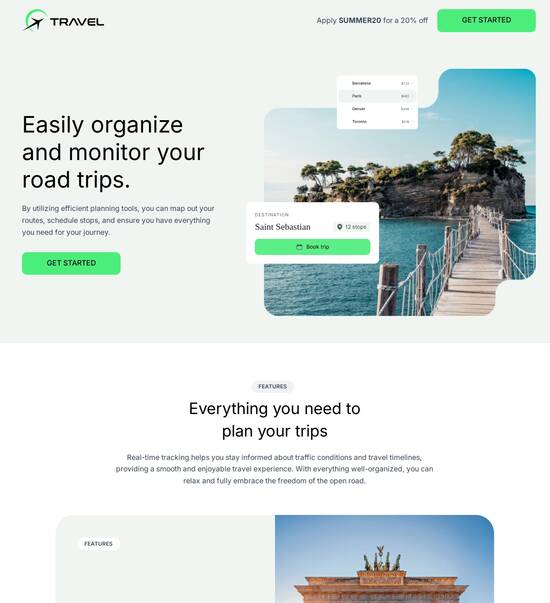
Static shopping cart page template
Explore Similar TemplatesAbout template
Unleash your creativity with the static shopping cart page template. Try Instapage today.
Recommended templates

Easy to build without coding
With the intuitive drag-and-drop builder, anyone on your team can create high-converting pages without any knowledge of code or design. Make enhancements to your landing page with custom widgets using Javascript, HTML/CSS, or third-party scripts.

Multiple layouts for any industry and goal
Select from 500+ landing page layouts built to boost conversions across industry-specific scenarios. Customize them by adjusting fonts, adding images, and generating on-brand content with the AI assistant. Quickly scale with Instablocks® and Global Blocks that you can save, reuse, and update globally.

Loads fast and looks polished on any device
Every template is responsive, which means they present professionally on any device and load blazingly fast with our Thor Render Engine. You can also power them up with Google AMP technology to deliver an unparalleled mobile experience and drive higher conversions.

Robust analytics & experimentation
Get real-time updates and reporting across all your devices, showing the number of visitors, conversions, cost-per-visitor, and cost-per-lead. Launch AI-powered experiments, run A/B tests, and use heatmaps to analyze user behavior, then optimize your landing page to maximize conversions.







Easy to build without coding
With the intuitive drag-and-drop builder, anyone on your team can create high-converting pages without any knowledge of code or design. Make enhancements to your landing page with custom widgets using Javascript, HTML/CSS, or third-party scripts.
Multiple layouts for any industry and goal
Select from 500+ landing page layouts built to boost conversions across industry-specific scenarios. Customize them by adjusting fonts, adding images, and generating on-brand content with the AI assistant. Quickly scale with Instablocks® and Global Blocks that you can save, reuse, and update globally.
Loads fast and looks polished on any device
Every template is responsive, which means they present professionally on any device and load blazingly fast with our Thor Render Engine.
Robust analytics & experimentation
Get real-time updates and reporting across all your devices, showing the number of visitors, conversions, cost-per-visitor, and cost-per-lead. Launch AI-powered experiments, run A/B tests, and use heatmaps to analyze user behavior, then optimize your landing page to maximize conversions.
All the features you need to build html shopping cart template
Explore more featuresLearn how to build top-performing landing pages for any goal
FAQs
Leading the way in building high-performing landing pages





Transform Your Campaigns with the Static Shopping Cart Page Template
Harness the power of Instapage's static shopping cart page template to enhance your eCommerce strategy. This guide will take you through the step-by-step process of utilizing this template effectively, ensuring a seamless experience for your users while maximizing conversion rates. By leveraging Instapage’s all-in-one platform, marketers can create high-performing pages tailored to their specific audiences.
Understanding the Importance of a Static Shopping Cart Page Template
A static shopping cart page template is essential for any eCommerce website as it eliminates confusion during the checkout process. By having a straightforward layout, users can quickly understand their selections and the next steps they need to take. This section highlights how Instapage's template can facilitate a smoother user journey.
- Clarity: A well-designed static shopping cart page offers clear summaries of selected items, pricing, and shipping information, reducing cart abandonment rates.
- Consistency: Implementing a static template ensures brand consistency across various touchpoints, enhancing customer trust.
- Efficiency: Instapage's builders allow for quicker deployment and testing, helping marketers adapt to user feedback effectively.
Step 1: Customize Your Static Shopping Cart Page Template
Begin by choosing one of Instapage's over 100 customizable templates that best suits your need. Focus on personalization options available. You can use dynamic text replacement to align text with the user's previous interactions.
Step 2: Optimize for Conversion with A/B Testing
Next, utilize built-in A/B testing features to optimize elements of your shopping cart page. Determine which images or call-to-action buttons lead to higher conversions. Use the analytics dashboard to track performance efficiently.
- Image optimization: Select images that appeal directly to different segments of your target audience.
- Call-to-action testing: Experiment with various button texts and colors to find what compels your users to click.
- Checkout flow analysis: Utilize heatmaps to see where users engage and where they drop off.
Step 3: Utilize Dynamic Content for Enhanced Personalization
Lastly, implement dynamic content features to create a personalized shopping experience. By tailoring the shopping cart page to individual user data, marketers can significantly improve user engagement.
- User-specific recommendations: Show related products based on previous interactions to encourage additional purchases.
- Location-based offers: Display shipping options or discounts relevant to the user's geographic location.
- Timeline-sensitive messages: Send reminders or create urgency by indicating limited-time deals.
Utilizing a static shopping cart page template via Instapage is essential for optimizing your eCommerce strategy. By following these steps, marketers can significantly enhance user experience and drive conversions.
Ready to take your eCommerce campaigns to the next level? Explore Instapage's powerful templates today and start transforming your landing pages for maximum impact.
People also ask about Static shopping cart page template
Understanding the static shopping cart page template
Understanding the static shopping cart page template
A static shopping cart page template serves as a foundational element for any e-commerce site. Unlike a dynamic shopping cart, which frequently updates and pulls data from databases in real-time, a static template is consistent in its design, presenting a fixed layout and structure. Its primary purpose is to offer a straightforward and reliable interface for customers, enabling them to review their selected products before proceeding to checkout.
The importance of the shopping cart in the e-commerce journey cannot be overstated. It acts as a pivotal point where customers decide whether to proceed with their purchases. A well-designed shopping cart can significantly influence conversion rates and enhance overall customer satisfaction. The distinction between static and dynamic shopping cart templates lies primarily in performance; static templates often load faster since they do not rely on complex database queries.
Core features of the static shopping cart template
A compelling static shopping cart page embodies several core features that enhance user convenience and clarity. Key components include well-organized product listings that present essential information such as descriptions, images, and pricing clearly. Additionally, compatibility with various e-commerce platforms and content management systems is crucial for seamless integration and functionality, ensuring that businesses can tailor their carts to fit unique branding needs.
Responsive design principles are also vital in static shopping cart templates, as users engage with e-commerce sites on diverse devices, from desktops to smartphones. Therefore, a well-designed template should adapt effortlessly to different screen sizes, maintaining clarity and usability across all platforms.
Key functionalities of a static shopping cart page
Understanding the essential elements of a shopping cart is key to enhancing the user experience. Static templates prominently feature product listings, which include detailed descriptions, high-quality images, and pricing information. These components play a significant role in helping customers make informed decisions about their purchases. The inclusion of quantity selectors and options for product variations allows customers to customize their orders quickly. Furthermore, functionalities like removal and update allow users to manage their selections without complications.
Interactive components are pivotal in enhancing user experience on a static shopping cart page. Utilizing features such as DOMContentLoaded and Document.addEventListener can improve interactivity by creating a responsive interface that reacts to users’ actions. Important buttons like 'Add to Cart' and 'Continue Shopping' are designed to be intuitive, ensuring users can navigate their experience with ease and efficiency, ultimately leading to a smoother checkout process.
The role of data in shopping cart management
Data plays a crucial role in effective shopping cart management, facilitating the tracking of purchases and user behavior. By utilizing data layers, website owners can capture insightful user interactions and optimize their offerings based on collected information. Tools like iolazy further contribute by optimizing image loading, which is critical in maintaining fast page performance, especially when handling multiple product images in a cart.
Integrating with analytics tools is essential for maximizing the shopping cart's effectiveness. For instance, leveraging the Pinterest Tag aids merchants in tracking conversions and engagement, providing valuable insights into customer preferences and behaviors. By analyzing this data, businesses can adjust product offerings and fine-tune their marketing strategies, driving further engagement and sales.
Structuring the static shopping cart template
Layout best practices are critical for structuring a static shopping cart template effectively. A well-designed totals table is key, as it clearly displays overall costs, including subtotals, taxes, and shipping charges. This transparency helps customers feel secure about their purchasing decisions. Organizing a product checkout table is another essential aspect, emphasizing clarity and efficiency during the final steps of the purchasing process, which can ultimately reduce cart abandonment rates.
Using table elements can significantly enhance data presentation in a shopping cart template. Tables provide an organized format for showcasing product details and pricing. Best practices for styling these tables—such as ensuring adequate spacing, using contrasting colors for headings, and maintaining legible font sizes—are important considerations that contribute to an effective user interface.
Seamless integration with e-commerce platforms
A vital aspect of static shopping cart templates is their compatibility with popular e-commerce platforms. Major websites like Shopify and WooCommerce facilitate the use of static templates, allowing businesses to create visually appealing and functional carts that align with their branding. Many platforms offer built-in features that enhance usability and aesthetics, making it easier for merchants to leverage static templates effectively.
Furthermore, utilizing plugins and extensions can greatly enhance the functionalities of static shopping cart templates. Many businesses opt for well-known plugins that assist in automating processes, improving user interface enhancements, or offering exclusive functionalities such as discount codes and loyalty rewards. These tools empower businesses to customize their shopping carts fully, ensuring they meet unique business goals.
Benefits of using a static shopping cart page template
One of the standout advantages of static shopping cart pages is their performance and speed. Static pages can significantly reduce load times due to the absence of complex database calls that dynamic pages rely on. This advantage can enhance user retention, as customers are likely to remain on a page that loads quickly, reducing the chances of frustrations that lead to cart abandonment.
Additionally, a well-organized static shopping cart contributes to an enhanced user experience, promoting a sense of trust and reliability during the purchasing process. When customers can easily navigate a clean, intuitive cart interface, their journey toward checkout becomes much smoother. This clarity can positively affect their perception of the brand, encouraging repeat purchases and improving overall customer loyalty.
Real-world applications and case studies
Several leading e-commerce brands have successfully optimized their shopping carts by implementing static templates. For instance, businesses in sectors like fashion, electronics, and home goods have reported increased conversion rates and enhanced customer satisfaction following the switch to static templates. These examples demonstrate that a streamlined shopping cart can effectively contribute to a better user journey, allowing customers to proceed to checkout without unnecessary distractions.
Performance metrics can help measure the effectiveness of shopping cart changes, providing a framework for assessing success. Key performance indicators (KPIs) such as cart abandonment rates and average time spent on the cart page are prudent metrics to analyze. By assessing these metrics pre and post-implementation of static templates, businesses can make data-driven decisions that refine their e-commerce strategies.
Future trends in shopping cart design
Looking forward, certain innovations are set to shape the future of shopping cart design. User behavior trends will increasingly drive how shopping experiences evolve, with customer expectations prioritizing speed, simplicity, and customization. Technologies such as artificial intelligence and machine learning are also emerging as transformative tools in personalizing shopping experiences, further enhancing the capabilities of static shopping carts.
As mobile commerce continues to grow, businesses must prepare their static templates for this shift in consumer habits. The integration of features like one-click checkout and subscription options may become norms in the shopping cart experience, emphasizing the need for adaptability. Brands willing to stay ahead of trends will find themselves better positioned to meet rapidly changing consumer expectations.
Practical tips for building your static shopping cart template
When building a static shopping cart template, there are several design and development considerations to keep in mind. First and foremost, prioritize an aesthetically pleasing layout that matches the overall branding of the e-commerce site. This includes proper color schemes, font choices, and imagery that collectively create a sense of cohesion within the user's experience. Employing whitespace thoughtfully will also make the page less cluttered and easier to navigate.
From a development standpoint, adhering to best practices ensures that the template is functional and easy to maintain. This includes writing clean code, implementing accessibility standards, and ensuring compatibility with various web browsers. Resources for customization and styling abound, ranging from CSS libraries that enhance user interfaces to community forums that foster shared knowledge and problem-solving among developers.
Ready to skyrocket conversions?
Supercharge your ad campaigns with high-performing landing pages
Get started














